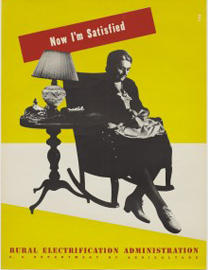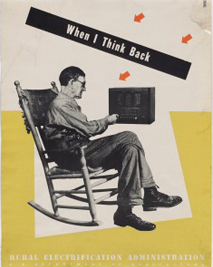I won’t be naming any names, but recently someone admitted to me that they just don’t “get” posters. I don’t get what’s not to get. Posters are all about “getting it”; they’re about telling us anything and everything in the most immediate visual language of text and imagery. Take the series of posters that Lester Beall designed for the U.S. government’s Rural Electrification Administration (REA), for example.

The Rural Electrification Administration was an agency created in 1935 under President Roosevelt’s New Deal program to do exactly what it sounds like—get electricity to rural areas. In the 1930s while some 90% of urban dwellers had electricity, only 10% of rural dwellers did. Working on the theory that affordable electricity would improve the standard of living and the economic competitiveness of America’s farm communities (and therefore the nation’s standard of living and economic situation), the REA sought to make loans available to rural communities to establish electricity cooperatives. Today this seems like a no-brainer, but as it turns out this campaign had no shortage of detractors in its time.

Six of the Beall’s REA posters were first shown at MoMA in November 1937 along with 12 posters from the Spanish government in the exhibition Spanish and U.S. Government Posters. “These two groups of posters are, however, far more worthy of serious consideration as works of art than can usually be accorded official design,” said Alfred H. Barr, Jr., then Director of the Museum, in the exhibition press announcement. He continues, “these posters display three conspicuous virtues in common: a sense of vigorous design, a modernity of style, and a boldness of symbolism.”